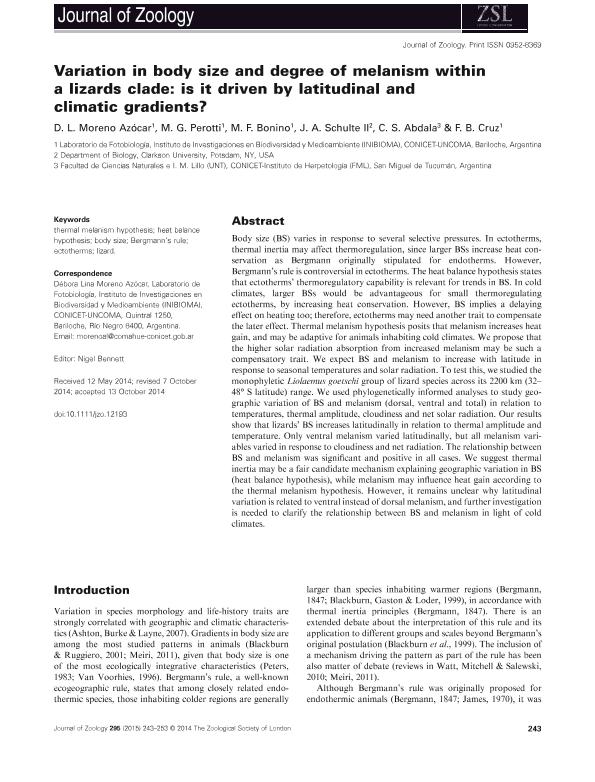Artículo
Variation in body size and degree of melanism within a lizards clade: is it driven by latitudinal and climatic gradients?
Moreno Azócar, Débora Lina ; Perotti, Maria Gabriela
; Perotti, Maria Gabriela ; Bonino, Marcelo Fabián
; Bonino, Marcelo Fabián ; Schulte, James; Abdala, Cristian Simón
; Schulte, James; Abdala, Cristian Simón ; Cruz, Felix Benjamin
; Cruz, Felix Benjamin
 ; Perotti, Maria Gabriela
; Perotti, Maria Gabriela ; Bonino, Marcelo Fabián
; Bonino, Marcelo Fabián ; Schulte, James; Abdala, Cristian Simón
; Schulte, James; Abdala, Cristian Simón ; Cruz, Felix Benjamin
; Cruz, Felix Benjamin
Fecha de publicación:
04/2015
Editorial:
Wiley
Revista:
Journal Of Zoology
ISSN:
0952-8369
e-ISSN:
1469-7998
Idioma:
Inglés
Tipo de recurso:
Artículo publicado
Clasificación temática:
Resumen
Body size (BS) varies in response to several selective pressures. In ectotherms, thermal inertia may affect thermoregulation, since larger BSs increase heat conservation as Bergmann originally stipulated for endotherms. However, Bergmann’s rule is controversial in ectotherms. The heat balance hypothesis states that ectotherms’ thermoregulatory capability is relevant for trends in BS. In cold climates, larger BSs would be advantageous for small thermoregulating ectotherms, by increasing heat conservation. However, BS implies a delaying effect on heating too; therefore, ectotherms may need another trait to compensate the later effect. Thermal melanism hypothesis posits that melanism increases heat gain, and may be adaptive for animals inhabiting cold climates. We propose that the higher solar radiation absorption from increased melanism may be such a compensatory trait. We expect BS and melanism to increase with latitude in response to seasonal temperatures and solar radiation. To test this, we studied the monophyletic Liolaemus goetschi group of lizard species across its 2200 km (32– 48° S latitude) range. We used phylogenetically informed analyses to study geographic variation of BS and melanism (dorsal, ventral and total) in relation to temperatures, thermal amplitude, cloudiness and net solar radiation. Our results show that lizards’ BS increases latitudinally in relation to thermal amplitude and temperature. Only ventral melanism varied latitudinally, but all melanism variables varied in response to cloudiness and net radiation. The relationship between BS and melanism was significant and positive in all cases. We suggest thermal inertia may be a fair candidate mechanism explaining geographic variation in BS (heat balance hypothesis), while melanism may influence heat gain according to the thermal melanism hypothesis. However, it remains unclear why latitudinal variation is related to ventral instead of dorsal melanism, and further investigation is needed to clarify the relationship between BS and melanism in light of cold climates.
Archivos asociados
Licencia
Identificadores
Colecciones
Articulos(INIBIOMA)
Articulos de INST. DE INVEST.EN BIODIVERSIDAD Y MEDIOAMBIENTE
Articulos de INST. DE INVEST.EN BIODIVERSIDAD Y MEDIOAMBIENTE
Citación
Moreno Azócar, Débora Lina; Perotti, Maria Gabriela; Bonino, Marcelo Fabián; Schulte, James; Abdala, Cristian Simón; et al.; Variation in body size and degree of melanism within a lizards clade: is it driven by latitudinal and climatic gradients?; Wiley; Journal Of Zoology; 295; 4; 4-2015; 243-253
Compartir
Altmétricas



